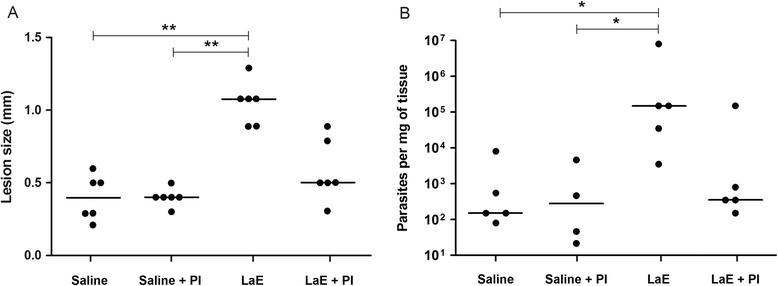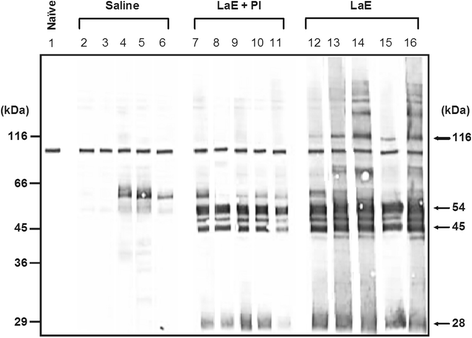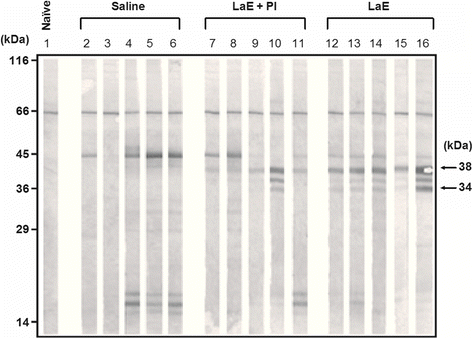Enhancement of experimental cutaneous leishmaniasis by Leishmania extract: identification of a disease-associated antibody specificity
- PMID: 25971623
- PMCID: PMC4440558
- DOI: 10.1186/s13104-015-1158-0
Enhancement of experimental cutaneous leishmaniasis by Leishmania extract: identification of a disease-associated antibody specificity
Abstract
Background: Both Leishmania braziliensis and Leishmania amazonensis induce cutaneous disease when injected in the skin of BALB/c mice. However, L. amazonensis may also visceralize in that strain of mice, infecting mainly the liver and spleen. In addition, whereas BALB/c mice die with a progressive cutaneous disease when infected by L. amazonensis, the infection by L. braziliensis is spontaneously cured. In a previous work, we have found that intravenous injections of L. amazonensis amastigote extract (LaE) potentiated a L. braziliensis infection in BALB/c mice, and that this infection-promoting activity could be inhibited by the addition of protease inhibitors to the extract.
Methods: In order to detect markers of disease evolution, in the present work we analyzed the specificity of the anti-L. amazonensis antibody response of L. braziliensis-infected BALB/c mice injected intravenously with saline or LaE, supplemented or not with protease inhibitors, by the Western blot technique.
Results: IgG1 antibodies recognizing an antigen with apparent molecular weight of 116 kDa were specifically detected in BALB/c mice that had been turned susceptible to L. braziliensis infection by injections of LaE.
Conclusion: A Th2 immune response (IgG1 antibody-producing) against this 116 kDa antigen, therefore, could be associated with susceptibility to severe Leishmania infection.
Figures



Similar articles
-
Enhancement of experimental cutaneous leishmaniasis by Leishmania molecules is dependent on interleukin-4, serine protease/esterase activity, and parasite and host genetic backgrounds.Infect Immun. 2011 Mar;79(3):1236-43. doi: 10.1128/IAI.00309-10. Epub 2010 Dec 20. Infect Immun. 2011. PMID: 21173308 Free PMC article.
-
Salivary gland homogenates from wild-caught sand flies Lutzomyia flaviscutellata and Lutzomyia (Psychodopygus) complexus showed inhibitory effects on Leishmania (Leishmania) amazonensis and Leishmania (Viannia) braziliensis infection in BALB/c mice.Int J Exp Pathol. 2014 Dec;95(6):418-26. doi: 10.1111/iep.12104. Epub 2014 Dec 5. Int J Exp Pathol. 2014. PMID: 25476864 Free PMC article.
-
Leishmania braziliensis and Leishmania amazonensis amastigote extracts differ in their enhancement effect on Leishmania infection when injected intradermally.BMC Res Notes. 2014 Feb 1;7:70. doi: 10.1186/1756-0500-7-70. BMC Res Notes. 2014. PMID: 24484604 Free PMC article.
-
Immunopathogenic competences of Leishmania (V.) braziliensis and L. (L.) amazonensis in American cutaneous leishmaniasis.Parasite Immunol. 2009 Aug;31(8):423-31. doi: 10.1111/j.1365-3024.2009.01116.x. Parasite Immunol. 2009. PMID: 19646206 Review.
-
Reviewing the role of the dendritic Langerhans cells in the immunopathogenesis of American cutaneous leishmaniasis.Trans R Soc Trop Med Hyg. 2008 Nov;102(11):1075-80. doi: 10.1016/j.trstmh.2008.05.020. Epub 2008 Jul 3. Trans R Soc Trop Med Hyg. 2008. PMID: 18602127 Review.
Cited by
-
Immunity to vector saliva is compromised by short sand fly seasons in endemic regions with temperate climates.Sci Rep. 2020 May 14;10(1):7990. doi: 10.1038/s41598-020-64820-9. Sci Rep. 2020. PMID: 32409684 Free PMC article.
References
-
- Almeida RP, Barral-Neto M, de Jesus AMR, de Freitas LAR, Carvalho EM, Barral A. Biological behavior of Leishmania amazonensis isolated from humans with cutaneous, mucosal, or visceral leishmaniasis in BALB/c mice. Am J Trop Med Hyg. 1996;54:178–84. - PubMed
-
- Leopoldo PT, Machado PR, Almeida RP, Schrifer A, Giudice A, de Jesus AR, et al. Differencial effects of antigens from L. braziliensis isolates from disseminated and cutaneous leishmaniasis on in vitro cytokine production. BMC Infect Dis. 2006;25:75–80. doi: 10.1186/1471-2334-6-75. - DOI - PMC - PubMed
Publication types
MeSH terms
Substances
LinkOut - more resources
Full Text Sources
Other Literature Sources

